目录
2.1 零碎基础知识
实例代码
#include <stdio.h>
int main(void) /*一个简单的C程序*/
{
int num; /*定义一个名为num的整性变量*/
num = 1; /*为num赋一个值*/
printf("I am a simple "); /*使用printf()函数*/
printf("computer.\n");
printf("My favorite number is %d because it is first.\n", num);
return 0;
}
运行结果:

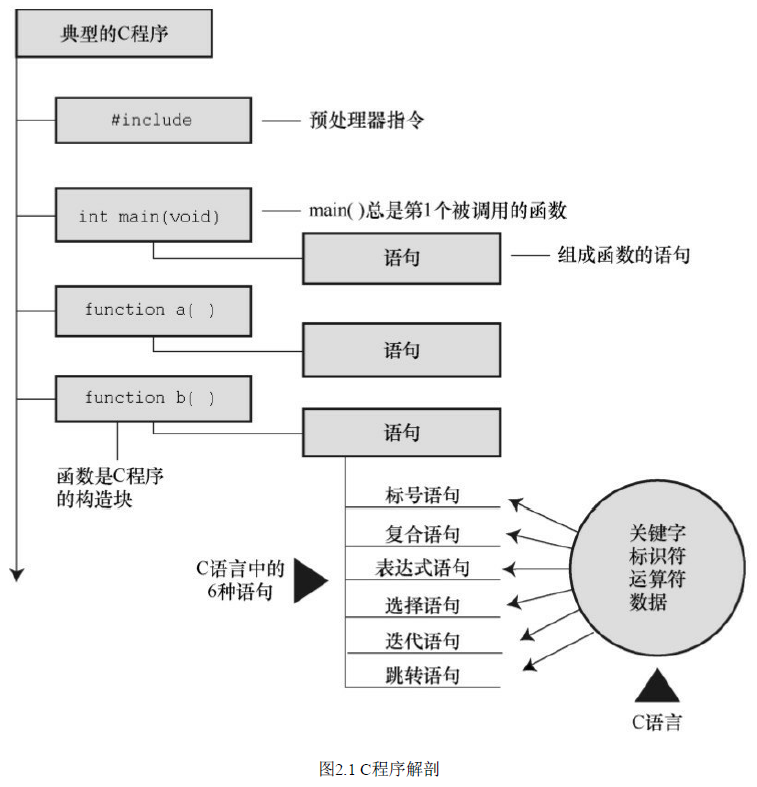
#include 指令和头文件
#include <stdio.h>(C预处理器指令)
作用相当于把stdio.h文件中的所有内容都输入该行所在的位置。实际上,这是一种“拷贝-粘贴”的操作。
int main(void)
标准形式,防止程序从一个编译器移至到另一个编译器出现问题。
注释/*一个简单的程序*/
当注释用于把一段代码注释掉,更好的办法是使用#if指令
#if 0
statements
#endif检测程序状态的方法
模拟计算机逐步执行程序
在程序中的关键点插入额外的printf()语句
使用调试器
关键字和保留标识符
关键字是C语言的词汇。它们对C而言比较特殊,不能用它们作为标识
符(如,变量名)。
在表 2.2 中所列的C语言关键字中,粗体表示的是C90标准新增的关键字,斜体表示的C99标准新增的关键字,粗斜体表示的是C11标准新增的关键字。
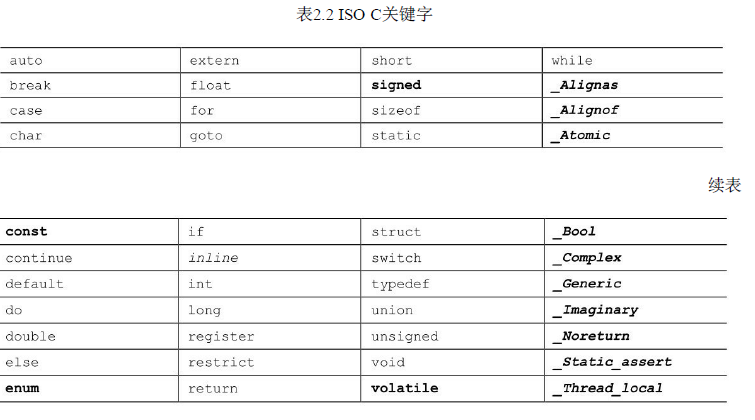
保留标识符包括那些以下划线字符开头的标识符和标准库函数名,如printf()。
2.2 课后复习题
1.C语言的基本模块是什么?
函数
2.什么是语法错误?写出一个英语例子和C语言例子。
语法错误违反了组成语句或程序的规则
3.什么是语义错误?写出一个英语例子和C语言例子。
语义错误是指含义错误
4.Indiana Sloth编写了下面的程序,并征求你的意见。请帮助他评定。
include studio.h
int main{void} /* 该程序打印一年有多少周 /*
( int s
s := 56;
print(There are s weeks in a year.);
return 0;
--------------------------------------------------
改正程序
#include <stdio.h>
int main(void)
{
int s;
s = 56;
printf("There are %d weeks in year.", s);
return 0;
}运行结果:

5.假设下面的4个例子都是完整程序中的一部分,它们都输出什么结果?
//A.
printf("Baa Baa Black Sheep.");
printf("Have you any wool?\n");
//B.
printf("Begone!\nO creature of lard!\n");
//C.
printf("What?\nNo/nfish?\n");
//D.
int num;
num = 2;
printf("%d + %d = %d", num, num, num + num);
运行结果:

6.在main、int、function、char、=中,哪些是C语言的关键字?
关键字:int char
main函数名; function函数; =运算符;
7.如何以下面的格式输出变量words和lines的值(这里,3020和350代表两个变量的值)? There were 3020 words and 350 lines.
int words, lines;
words = 3020; lines = 350;
printf("There were %d words and %d lines.\n",words,lines);
运行结果:

8.考虑下面的程序:
#include<stdio.h>
int main(void)
{
int a,b;
a=5; b = 2; /* 第7行 */
b = a; /* 第8行 */
a = b; /* 第9行 */
printf("%d %d\n",b,a);
return 0;
}
9.考虑下面的程序:
#include<stdio.h>
int main(void)
{
int x,y;
x=10;
y = 5; /*第7行*/
y = x + y; /*第8行*/
x = x*y; /*第9行*/
printf("%d %d\n",x,y);
return 0;
}
2.3编程题
1.编写一个程序,调用一次 printf()函数,把你的姓名打印在一行。再调用一次 printf()函数,把你的姓名分别打印在两行。然后,再调用两次printf()函数,把你的姓名打印在一行。输出应如下所示(当然要把示例的内容换成你的姓名):

#include<stdio.h>
int main(void)
{
printf("xiao zhou\n");
printf("xiao\nzhou\n");
printf("xiao ");
printf("zhou\n");
return 0;
}运行结果:

2.编写一个程序,打印你的姓名和地址。
#include<stdio.h>
int main(void)
{
printf("xiao zhou\naddress:China\n");
return 0;
}运行结果:

3.编写一个程序把你的年龄转换成天数,并显示这两个值。这里不用考虑闰年的问题。
#include <stdio.h>
int main(void)
{
printf("%d years is %d days", 20, 20 * 365);
return 0;
}运行结果:

4.编写一个程序,生成以下输出:
除了 main()函数以外,该程序还要调用两个自定义函数:一个名为jolly(),用于打印前 3 条消息,调用一次打印一条;另一个函数名为deny(),打印最后一条消息。
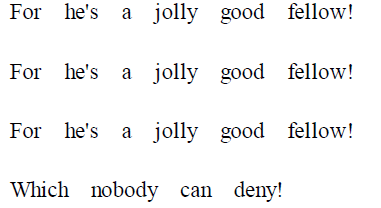
#include <stdio.h>
int jolly(void);
int deny(void);
int main(void)
{
int i = 0;
while (i < 3)
{
i++;
jolly();
}
deny();
return 0;
}
int jolly(void)
{
printf("For he's a jolly good fellow!\n");
return 0;
}
int deny(void)
{
printf("Which nobody can deny!\n");
return 0;
}运行结果:

5.编写一个程序,生成以下输出:
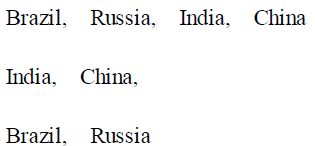
除了main()以外,该程序还要调用两个自定义函数:一个名为br(),调用一次打印一次“Brazil, Russia”;另一个名为ic(),调用一次打印一次“India,China”。其他内容在main()函数中完成。
#include <stdio.h>
int br(void);
int ic(void);
int main(void)
{
br();
ic();
ic();
br();
return 0;
}
int br(void)
{
printf("Brazil, Russia.");
return 0;
}
int ic(void)
{
printf("India, China.\n");
return 0;
}运行结果:

6.编写一个程序,创建一个整型变量toes,并将toes设置为10。程序中还要计算toes的两倍和toes的平方。该程序应打印3个值,并分别描述以示区分
#include <stdio.h>
int main(void)
{
int toes = 10;
printf("toes is %d\n", toes); /*toes的值*/
printf("toes*2 is %d\n", toes*2); /*toes的二倍*/
printf("toes^2 is %d\n", toes*toes); /*toes的平方*/
return 0;
}运行结果:

7.许多研究表明,微笑益处多多。编写一个程序,生成以下格式的输出:
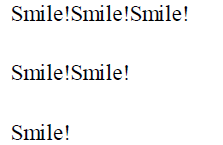
该程序要定义一个函数,该函数被调用一次打印一次“Smile!”,根据程序的需要使用该函数。
#include <stdio.h>
int smile(void);
int main(void)
{
int i = 0, j;
for (i = 0; i < 3; i++)
{
for (j = i; j < 3; j++)
smile();
printf("\n");
}
return 0;
}
int smile(void)
{
printf("Smile!");
return 0;
}运行结果:

8.在C语言中,函数可以调用另一个函数。编写一个程序,调用一个名为one_three()的函数。该函数在一行打印单词“one”,再调用第2个函数two(),然后在另一行打印单词“three”。two()函数在一行显示单词“two”。main()函数在调用 one_three()函数前要打印短语“starting now:”,并在调用完毕后显示短语“done!”。因此,该程序的输出应如下所示:
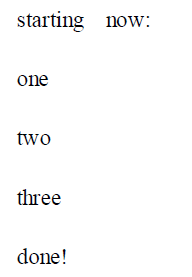
#include <stdio.h>
int one_three(void);
int two(void);
int main(void)
{
printf("starting now\n");
one_three();
printf("done!\n");
return 0;
}
int one_three(void)
{
printf("one\n");
two();
printf("three\n");
return 0;
}
int two(void)
{
printf("two\n");
return 0;
}运行结果:






















 1426
1426











 被折叠的 条评论
为什么被折叠?
被折叠的 条评论
为什么被折叠?








